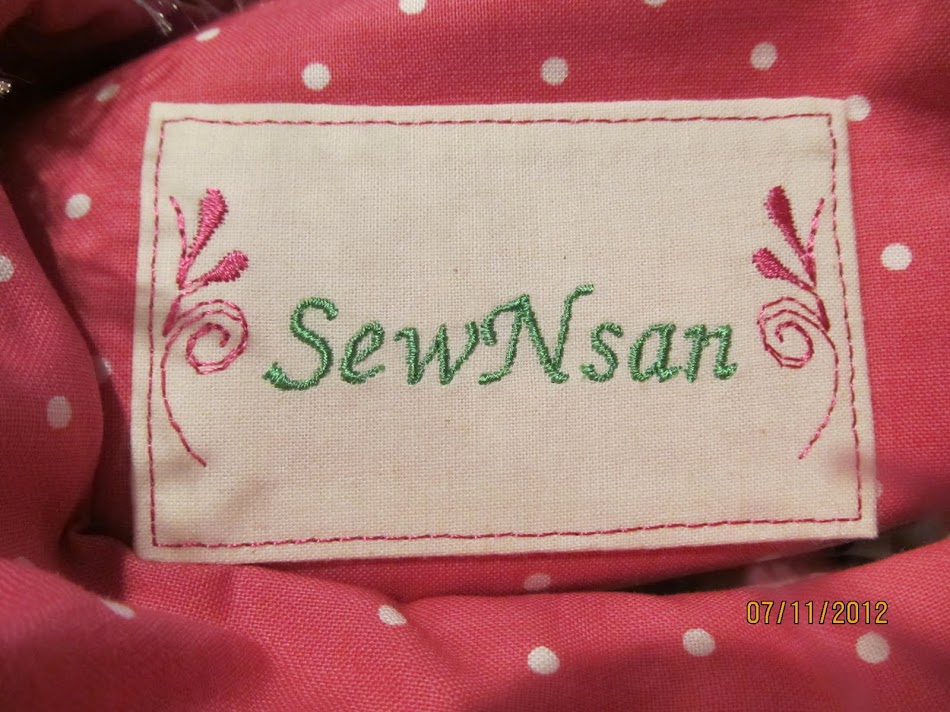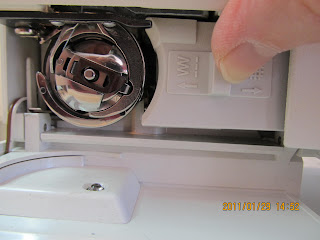I took the throat plate off, took out the needle, unscrewed the presser foot ankle and removed it along with the presser foot. I opened the bobbin assembly area door and took out the bobbin case. Next, I lowered the feed teeth so I could clean out any lint and dust that had accumulated in that area.
I raised the presser foot and turned the tension dial to zero. A folded piece of fine muslin can be slid from top to bottom in between the tension discs to clean out any dust/lint (suggested by Threads Magazine), or a length of small gauge crochet thread can be run through the tension discs in the same manner. The crochet thread is larger than regular sewing thread and it will remove hunks of dust/lint from the tension disc area. This downward movement allows the dust/lint to be pulled out to the bottom of the disc assembly, and not push it back into the area. When re-threading your machine, after cleaning is completed, remember to re-set the tension dial to an appropriate setting for your next project.
TIP: When changing thread, cut it above the tension disc assembly then pull it out through the needle area to remove it, thereby pulling out any accumulation of dust/lint in that area (and not pulling it back up into the tension discs).
Next, I dipped the machine cleaning brush into some rubbing alcohol,and squeezed out the excess. Alcohol makes the brush attract dust/lint better and allows me to pull clumps of it out of the machine.
This shows how easy it is to clean out the feed teeth area. Also, on my machine, I hold my brush on the top of the bobbin hook race assembly (seen above), while I turn the handwheel to clean off that area.
The presser bar needs attention, too! Sometimes, lint/dust can accumulate in this area. It usually won't affect the machine's ability to stitch properly, but just for the principle of it I like to clean this area.
After removing the bobbin from its case, I run the cleaning brush around the inside of the bobbin case to make sure it's dust free. On some machines, the hook assembly can be removed. Check your instruction manual for details on how this is done. I can't remove mine, but on many machines it is removable.
If you have a special attachment that fits on your vacuum cleaner, you can use it to vacuum out all of the dust and lint inside your machine. You know, the kind that is used for cleaning computer keyboards. It has two sizes of small brush extensions and a small crevice extension. I have found that this attachment makes cleaning my machine so much easier, and it does a more thorough job. This is a good time to vacuum every area that is exposed. I like to vacuum-dust the outside of my machine, also. Oh, and don't forget, vacuum-dust the foot pedal. Dust can accumulate inside it, as well, and can affect how it operates.
I DO NOT recommend using a product called "canned air" to blow dust/lint out of sewing machines. I don't like that it could blow everything further into the machine, making it nearly impossible to remove. NEVER, never blow your breath into your machine, for any reason! You're blowing moisture into the machine which can cause corrosion or rusting. Not good!
At this point, I add a single drop of sewing machine oil to the bobbin hook race area where the metal parts move against each other. (I don't add oil more frequently than once a year, unless I've been using my machine for long periods of time.) Do not add more than one drop of oil because it can gum up the area over time. Actually, I like to just take a paper towel or a soft piece of muslin to wipe out any excess oil so there won't be too much, which can cause a gumming problem later.
If your hook race assembly can be removed, wipe it off with the soft cloth that has a tiny drop of oil on it. Use a good quality sewing machine oil, not household oil. Sewing machine oil is a specially formulated, petroleum-based oil made for sewing machines and is a light oil. Household oil is a heavier oil. Some oils can actually cause corrosion and build-up inside the machine. Remember, less is more (in this case)!
Some older machines have holes in the throat plate area where a drop of oil can be placed, but most newer machines do not have this option. After the machine is completely cleaned and put back together, but before threading the top thread, run it at top speed for about a minute to distribute the oil evenly in the bobbin assembly.
Unless your machine instruction manual specifically tells you NOT to oil your machine, you can give it ONE drop of oil in the bobbin area. My machine had been sounding a little loud until I put in the oil. Now, it sounds much more quiet and has a smooth-running sound.
Here, the bobbin has been placed back in its case, then I'm replacing the bobbin case in its proper position. If you have removed your hook race assembly, check your manual for instructions on how to replace it. It has to go back into the machine in a certain sequence, and it fits together very specifically.
I always make sure the bobbin case is seated properly so it won't vibrate out of its position. The black lever in the center, when released back to be flat against the bobbin case, locks the bobbin into place. (This is the lever that is pulled forward to pull the bobbin case out of the machine, on a front loading bobbin.) If your machine has a drop-in bobbin, check your manual for removal instructions. Some can be removed, others cannot.
Next, I have replaced the needle, making sure the flat side of the shaft is placed toward the back of the machine. Some older model machines will require the flat side of the needle be placed to the right side, or the left side. Also, make sure the needle is shoved all the way up into the opening before tightening the needle screw.
Make sure the needle screw is tightened so the needle won't fall out! I hate to admit it, but I've had a needle, or two, fall out. It's kind of scary when that happens, because the needle point could get caught in the feed teeth and damage the machine or bend or break the needle. That can cause some real trouble!
TIP: Never, never sew over pins!!!!!! The needle could strike a pin and break! The needle fragments can fly into your eye, or can damage your sewing machine. Metal shavings can accumulate in the bobbin area and can cause problems. Sewing over pins can dull the point of the needle or cause a burr, shortening its life and causing faulty stitch formation. Just get out of the habit of sewing over pins, if you have that habit, please!
Be sure to raise the feed teeth back into the sewing position. I can't tell you how many times I have forgotten to raise my feed teeth! The sewing machine will not sew forward unless the feed teeth are in the up position.
If you follow the steps I've suggested to clean and maintain your sewing machine after every six to eight hours of sewing, or even after each project, you'll have fewer issues with your machine, fewer stitch problems and a much smoother-running sewing machine. Form a new habit and do a quick cleaning with your brush before starting every new project.
The six to eight hour rule of thumb is good to follow for changing the needle, as well. Don't wait until your needle gets so dull that it prevents good stitch formation, or when your needle gets bent or gets a burr on it. Purchase several packs of needles when notions are on sale at your local dealership or fabric store, so you'll have a supply on hand.
My recommendation is to keep your machine(s) covered when not in use. I use vintage pillow cases that have pretty embroidery on them to just place over my sewing machines and my serger. They don't really "fit" onto the machines, so I just lay them over the top of the machines. It works!
Before beginning a cleaning session, check your machine instruction manual for specific instructions on how to take everything apart, and if/where to oil your machine. Keep in mind that too much oil can spread into the wiring of a sewing machine, which will cause a new set of problems. So, be cautious when oiling!
Cleaning your serger is similar to what I've described here. I especially like to use my vacuum attachment to pull out all of the dust/lint from around the loopers and the feed teeth areas. It's fast and works very well!
Threads Magazine recommends taking your machine to your dealership or authorized mechanic every two years for a tune-up. My experience has been that by keeping my machine clean, as outlined here, it cuts down on the number of times I have to take my machine in for tune-ups.
I hope you have enjoyed this mini-lesson on machine cleaning. I love hearing the smooth, "purring" sound of my machine when it's thoroughly clean - kind of like being able to see clearly through a freshly washed window on a sunny day!
Please leave me a comment, below, if you have any questions, or to tell me if this tutorial is not understandable. Thank you!











Thanks for the well stated tips and the pictures really helped.
ReplyDeleteDear Anonymous,
ReplyDeleteYou're welcome, and thank you! I'm so glad you stopped by to see my tutorial! I hope you will refer your sewing friends to this blog post if they have any questions about cleaning their sewing machines.